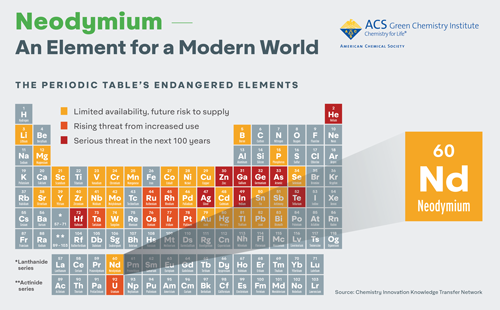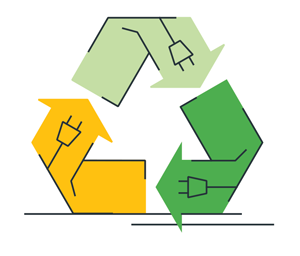Neodymium
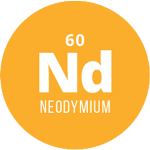
What is Neodymium?
Neodymium is one of the more reactive lanthanides—a group of similar metallic elements numbered 57-71 on the periodic table. These 15 elements, plus scandium and yttrium, are termed “rare earth elements” (REEs). Despite the name, most of these elements are relatively common in the Earth’s crust, but economically exploitable deposits are relatively sparse. Rare earths have important uses in a number of key applications for multiple advanced technologies in electronics, transportation, energy and defense.
Creating a sustainable, circular economy for neodymium will empower us to meet U.N. Sustainable Development Goal #11: Sustainable Cities and Communities.
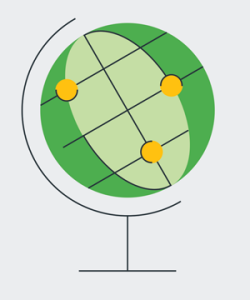
Where is Neodymium Found?
Neodymium is primarily mined as part of a conglomerate with other rare earth elements in the monazite and bastnaesite mineral deposits. Historically, a single mine in California produced most of the world’s rare earth minerals, but since the early 90s, China has become the world’s primary source.
At its peak in 2011, China supplied over 95% of all the REEs.
Today China supplies 70% of the world’s REEs, with new mines in Australia and a reopened U.S. mine contributing. Mining and processing rare earths has caused extensive environmental pollution in China.
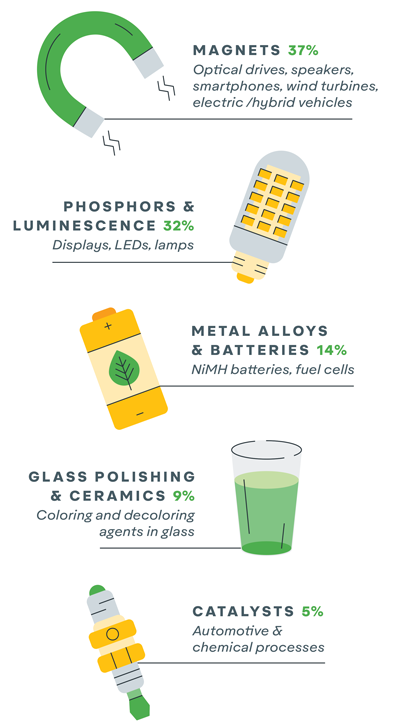
How is Neodymium Used?
In 1983, researchers discovered that neodymium combined with iron and boron made a very strong permanent magnet. This enabled the miniaturization of electronics such as loudspeakers, computer hard drives, mobile phones, and electronic automobile components.
Today the largest demand for high-performance neodymium-iron-boron magnets is in the motors of electric and hybrid vehicles. For example, each Toyota Prius is reported to contain as much as 1 kg of neodymium in its motor. Neodymium magnets are also used in wind turbines, aeronautics and space.
Other uses of neodymium include making a specialized glass used in protective goggles for welding and glass blowing, and in applications such as surgical lasers and laser pointers. Finally, it is used as a catalyst in polymerization reactions.
Why is Neodymium a Critical Element?
- Recovery is expensive and underdeveloped
- REEs are lost during electronic waste recycling
- Demand is growing
- Geopolitical concerns
Current recycling costs are high and infrastructure to recover REEs from electronic motors is underdeveloped, although several companies and researchers are actively developing recycling technologies.
Most electronic waste is shredded during the recycling process leading to the loss of REEs in dust and ferrous fractions. Since REEs make up only a small percentage of the material in electronic waste, the economic viability of recycling them is challenging with current technology.
As important components of powerful batteries, magnets, photovoltaics, etc., REEs are enabling the clean energy economy. As demand for electric cars, wind turbines, solar panels and other high-tech devices grows, the supply pressure on REEs will also grow.
REEs are “critical resources” due to their important applications in industry and defense and because of the geopolitical risk of the supply chain being concentrated in primarily one country. For example, in 2011, China restricted REEs exportation (cutting off Japan entirely), causing a massive price spike. In 2019, China brought up REEs as a point of negotiation during trade talks with the U.S., prompting the U.S. to pursue alternative sources with Canada.
What Can We Do to Save Neodymium?
Chemists
- Design electronics with end-of-life recycling in mind.
- Develop recycling capability to recover REEs from spent permanent magnets. Several studies estimate the potential level of recycling of REEs to be around 40% within the next 20 years.
- Research alternatives to neodymium use in magnets.
- Alternatives to using REEs in electric and hybrid motors should be explored, such as Tesla's rare-earth-free induction motor.

Individuals
- Think twice before upgrading or buying new electronics.
- Consider reuse and recycling options when discarding electronic waste.
Institutions
- Promote resource efficiency, material recovery and recycling, including investments in R&D, in order to reduce demand for REEs and critical raw materials more generally.
- Strengthen supply chains by building in diversity from mining to processing to manufacturing.
-
1. Tsamis, A.; Coyne, M. Recovery of Rare Earths from Electronic Wastes: An Opportunity for High-Tech SMEs. Directorate-General for Internal Policies document IP/A/ITRE/2014-09; PE 518.777; European Parliament, 2014 http://www.europarl.europa.eu/RegData/etudes/STUD/2015/518777/IPOL_STU(2015)518777_EN.pdf (accessed 2/25/2020)
2. Haxel, G. B.; Hedrick, J. B.; Orris, G. J. Rare Earth Elements—Critical Resources for High Technology. Fact Sheet 087-02; U.S. Geological Survey, 2002. https://pubs.usgs.gov/fs/2002/fs087-02/
3. U.S. Geological Survey, Mineral Commodity Summaries, February 2019, pp 132-133. https://prd-wret.s3-us-west-2.amazonaws.com/assets/palladium/production/atoms/files/mcs2019_all.pdf
4. Standaert, M. China Wrestles with the Toxic Aftermath of Rare Earth Mining. Yale 360. July 2, 2019. https://e360.yale.edu/features/china-wrestles-with-the-toxic-aftermath-of-rare-earth-mining
5. Davis, E.; Renner, R. Endangered Elements: Critical Thinking. Chemistry World, January 2011, pp 50-54. https://www.rsc.org/images/Endangered%20Elements%20-%20Critical%20Thinking_tcm18-196054.pdf
6. King, H. Rare Earth Element Production. Chart from REE - Rare Earth Elements and their Uses. Accessed February 25, 2020 from: https://geology.com/articles/rare-earth-elements/
7. Royal Society of Chemistry Periodic Table, Neodymium. http://www.rsc.org/periodic-table/element/60/neodymium (accessed 2/25/2020)
8. Part 3 of 3. Report on Critical Raw Materials and the Circular Economy. SWD (2018) 36 final; European Commission: Brussels, Belgium, 2018; 32-68. https://ec.europa.eu/commission/publications/report-critical-raw-materials-and-circular-economy_en (accessed 2/25/2020)
9. Lombrana, L. M.; Argitis, T. U.S. and Canada Discuss Supply of Rare Earths as China Dominates. Bloomberg, September 30, 2019. https://www.bloomberg.com/news/articles/2019-09-30/u-s-and-canada-discuss-supply-of-rare-earths-as-china-dominates
10. Ritchie, M.; Zhu, W. Xi’s Trip to Rare-Earths Plant Stokes Talk of Trade Retaliation. Bloomberg News, May 20, 2019. https://www.bloomberg.com/news/articles/2019-05-20/xi-s-trip-to-rare-earths-plant-stokes-talk-of-trade-retaliation
11. McDonald, Z. Rare Earth Elements Aren’t as Vital to Hybrids and EVs as You Might Think. Plugin Cars. May 17, 2011. https://www.plugincars.com/rare-earth-elements-arent-actually-necessary-evs-or-hybrids-107194.html
12. A Federal Strategy to Ensure Secure and Reliable Supplies of Critical Minerals. U.S. Department of Commerce Report. 2019. https://www.commerce.gov/news/reports/2019/06/federal-strategy-ensure-secure-and-reliable-supplies-critical-minerals (accessed 2/25/2020)
ACS GCI's Green Chemistry and Engineering Conference
The 28th Annual Green Chemistry & Engineering Conference will be held June 2-5, 2024 in Atlanta, Georgia, with the theme AI-Generated Green Chemistry.

